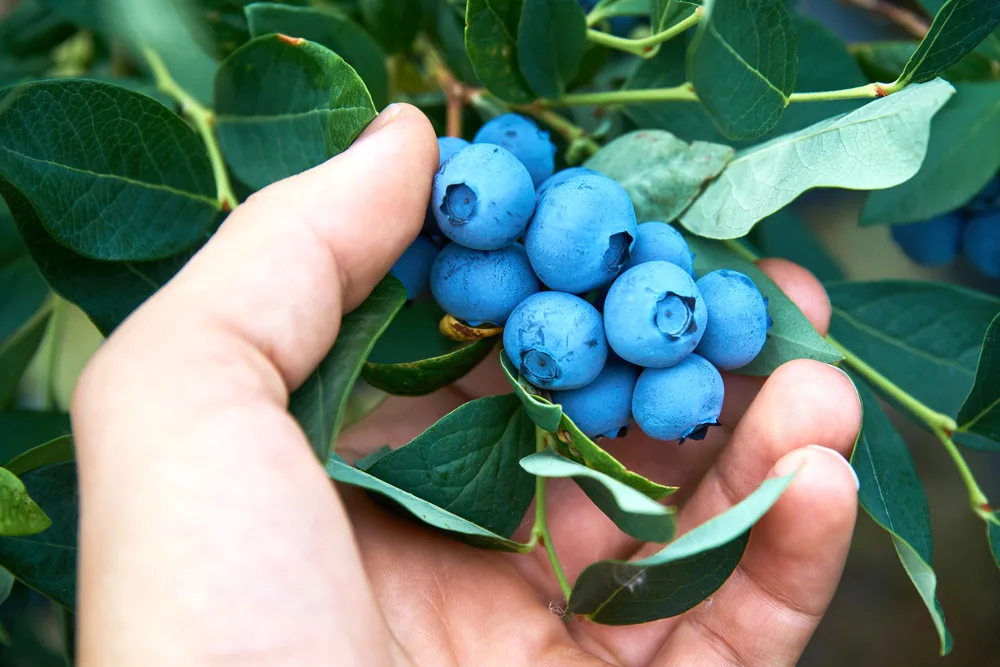
It does not matter whether you have a large property, a tiny garden, or no garden at all, container gardening is a great solution for growing a range of different plants.
Blueberries are one edible crop that does well when grown in containers, so in this article, we’ll take a look at how to grow blueberries in pots.
Related Reading: 20 Fruit Canes Or Bushes To Grow In Your Garden
Why Grow Blueberries in Pots?
Blueberries are a great crop to grow. They are incredibly good for you – rich in vitamins and high in antioxidants.
They can often be eaten straight from the bush, and can also be cooked up and used in a wide range of recipes.
What is more, blueberries are attractive plants too.
After the fruits have been harvested, the foliage’s fabulous fall colours give the plants plenty of ornamental appeal.
But why grow them in pots or other containers?
Well, blueberries lend themselves to this sort of cultivation because of their needs and requirements.
In particular, blueberries are often grown in pots because of their need for acidic growing conditions.
Unless you have acidic soil where you live, or can amend the soil accordingly, growing blueberries in containers is the best way to get a worthwhile crop.
Even if you do have acid soil suitable for these ericaceous (acid-loving) plants, you may find that blueberries do better in pots than they do in the ground.
You may encounter one potential problem – waterlogged or boggy ground.
Blueberries do like relatively moist conditions, but don’t like to ‘paddle’. When grown in heavier, more clay-rich soils, blueberries may suffer due to water retention around their roots.
In a container, it is often easier to achieve the moist yet free-draining conditions that are required.
Choosing Your Plants
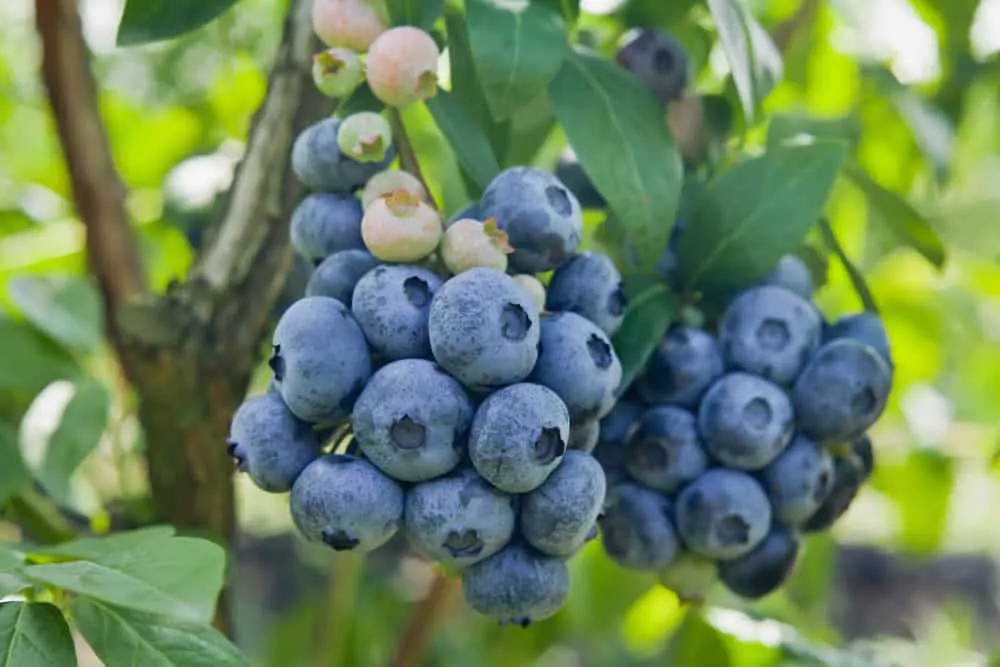
If you want to grow blueberries in pots, the first thing to decide is which blueberries you would like to grow.
Let’s begin by taking a look at which plants we actually mean when we say ‘blueberries’:
What Are Blueberries?
Blueberries are perennial fruiting shrubs in the genus Vaccinium. There are actually a number of different plant species within this genus that are given the name ‘blueberry’.
Which plants the name refers to largely depends on where you are.
So before you delve further into which options to grow, it is important to understand which plants we are talking about.
In North America, there are two main types of commercial blueberry:
- Highbush blueberries (V. corymbosum) (from which most cultivated blueberries are derived)
- Lowbush blueberries (V. angustifolium etc.) (wild blueberries – which are sometimes also semi-managed or cultivated on a smaller scale).
Many different varieties are found within these two categories – both wild blueberries with different native ranges, and cultivars developed for specific characteristics, particularly larger or more flavoursome fruit.
Cultivars have also been bred to suit the conditions in more southerly states, outwith the blueberry’s original native range.
Rabbiteye blueberry, for example, is a southern type that is produced from the Carolinas to the Gulf Coast States.
Northern Highbush blueberries have been hybridized with other southern-adapted Vaccinium species to create a range of cultivars known as Southern highbush blueberries.
To add to the confusion, related plants such as huckleberries and whortleberries are also sometimes called ‘blueberries’ or sold as blueberry jam or other such products.
In Europe, and elsewhere, American blueberries are often for sale commercially.
However, different species are also sometimes referred to as ‘blueberries’ – most frequently the ‘European blueberry’ or bilberry/ blaeberry, (V. myrtillus).
These are rarely cultivated commercially, though can also be grown in the right conditions in a small scale/ domestic setting.
They have smaller (though some say, more flavoursome) berries.
Choosing Blueberry Cultivars for Containers
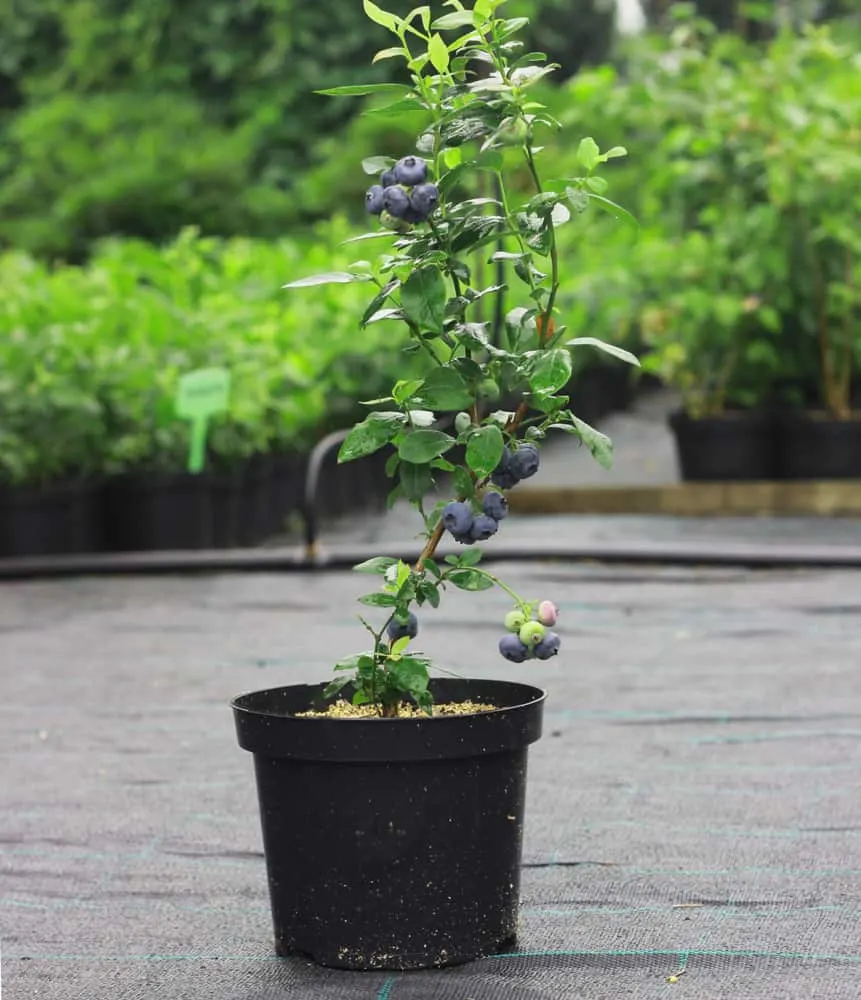
Most often, the blueberries chosen for containers are American highbush types. These are often grown on a dwarfing rootstock so as to produce smaller plants.
Generally speaking, highbush types have an upright growth habit, and will grow to around 3-5ft tall if allowed to do so.
Dwarf blueberries will be smaller, and growth can be limited to as little as 2ft.
Some popular American blueberry cultivars to consider if you want to grow blueberries in pots are listed below with links to purchase online.
- Top Hat (zones 4-7).
- Sunshine Blue (zones 5-10).
- Pink Popcorn (zones 4-8) – This is an unusual option with pink berries.
- Pink Icing (zones 5-10).
- Bluecrop (zones 4-7) – This is the most popular blueberry variety in the world.
- Duke (zones 5-8).
- Spartan (zones 5-7).
Of course, there are also a huge number of other cultivars to consider.

If you are serious about growing blueberries, then consider purchasing this collection of ten different blueberry bush cultivars – including many of those listed above.
It includes ten blueberry starter plugs, plus 500 seeds and a bonus cranberry starter plant.
Which option you go for should depend on where you live and the conditions to be found there, not just the characteristics of the variety in question.
Note: Not all blueberries are self-fertile. Sometimes they require a partner for pollination. Even when they are self fertile, blueberries will usually fruit better when grown with at least one companion.
For this reason, it is best to choose to grow at least two or three blueberries in pots at the same time.
Local gardeners, or experts at your local garden centre or plant nursery should be able to guide you, and help you choose varieties that will do well in your area, and do well with one another.
When each variety crops should also have a hearing on which varieties you decide to grow.
By choosing an early cropping, mid season and late cropping option, you could dramatically extend your period of harvest.
When To Buy Blueberry Plants
Pot grown blueberries can generally be bought all year round. Bare root blueberries can also be chosen and ordered in fall, for planting out during the dormant period.
For best results, whether you choose pot grown or bare root options, you should purchase your blueberries in either early spring, or in fall, when their transplantation to their new pots or containers will be less stressful.
Choosing Your Container
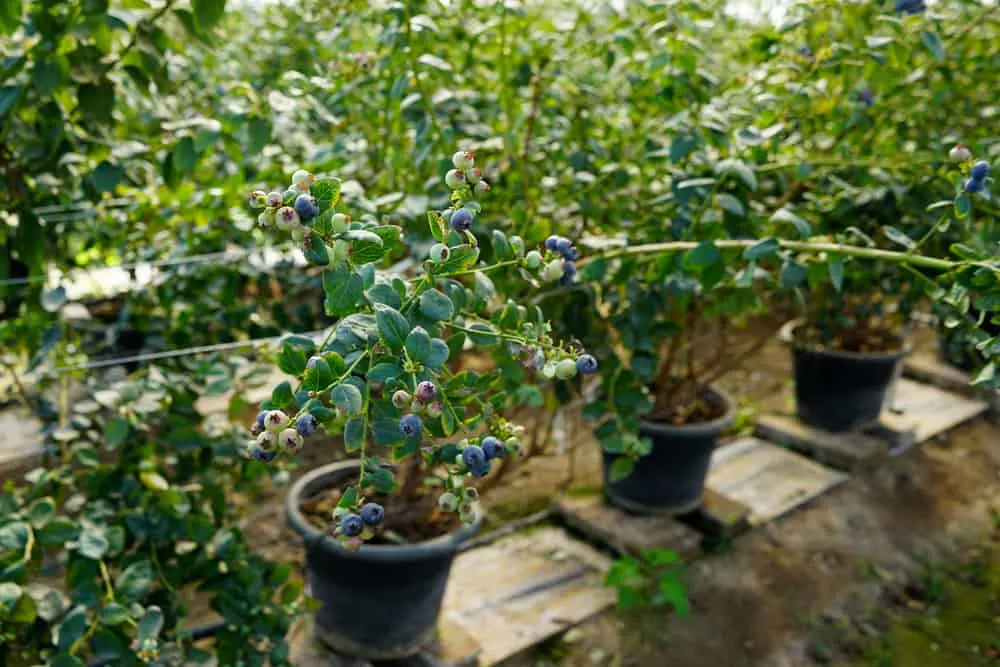
Choosing the right container or containers is just as important as choosing the right plants.
It is important to note that even when blueberries come in the pot in which they were grown, this does not mean that they can be kept in it.
Pot grown plants often come in pots that are now too small for the plants which have almost outgrown them.
Both young, pot grown and bare root blueberries should ideally be planted into containers no smaller than 30cm (12 inches) in diameter and ideally larger.
For best results, your container should be at least 18 inches deep.
As soon as your plant outgrows the 30cm (12 inch pot), or if you have purchased a larger blueberry bush, 50cm (20 inches) is really the minimum diameter you should consider for your pot or other container.
Really – it is a case of the bigger the better.
Though when choosing, you might want to think about whether or not you will need to move the pots around.
Container Options for Your Blueberries
There are plenty of beautiful pots out there for your blueberries. Bear in mind that if you want to live as sustainably as possible, you should try to avoid using plastic/ composite resins in your garden whenever you can.
Fortunately, there are plenty of other pots you can choose that are not made of plastic. For example, you could choose:
- A large terracotta/ ceramic pot.
- A wooden planter.
- A metal planter.
Bear in mind, however, that you do not necessarily have to buy the containers when you want to grow blueberries in pots.
You could also consider doing a spot of upcycling. Reclaiming materials that would otherwise have been thrown away can be a great way to get new growing areas. For example, you could:
- Plant blueberries in old 5 gallon buckets.
- Use old 55 gallon barrels to make larger planters.
- Use reclaimed wood to make your planters.
- Make grow bags from potato sacks or similar.
- Upcycle an old sink or tub to grow your blueberries in.
Whether you buy or make your containers, make sure that they have good drainage.
Make holes in the bottom of pots, planters and containers to let out the water, and place crocks, rocks etc. in the bases so the roots don’t get waterlogged.
Preparing The Growing Medium
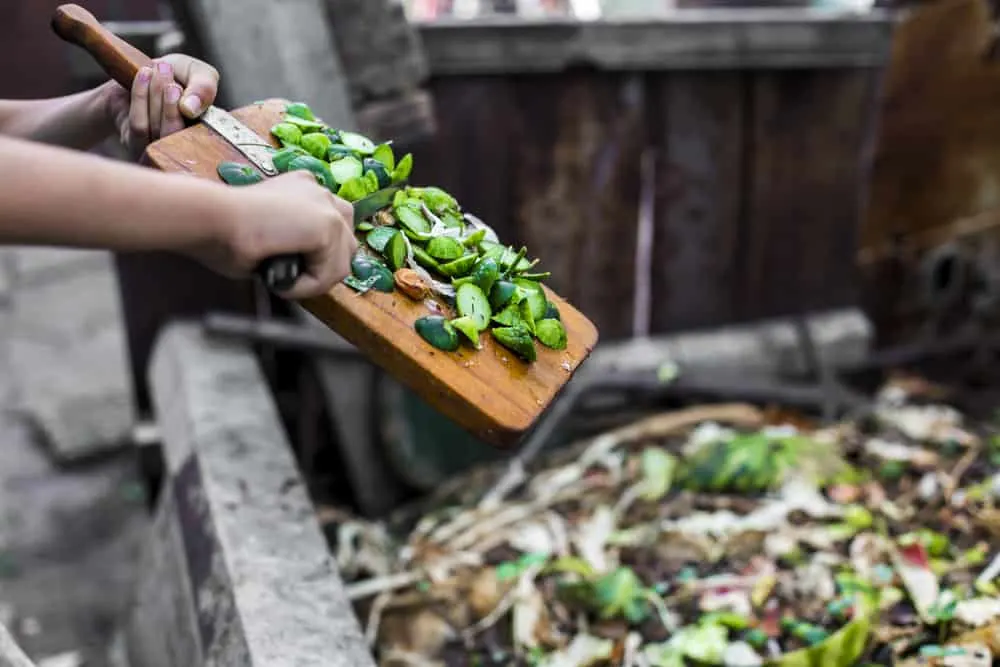
Since blueberries are ericaceous, it is important to use a growing medium with an acid pH. The pH of the soil/ compost in your pots or containers should be at 5.5 or lower in order to avoid any problems.
While you can purchase ericaceous compost, it is worthwhile looking for a peat free variety to be kinder to our planet.
You can also consider making your own compost for acid loving plants.
While in most instances, you are looking to achieve a neutral pH when you make compost at home, you can make your compost more acidic by:
- Adding plenty of pine needles and conifer bark & wood chippings.
- Adding plenty of oak and beech leaves or, ideally, leaf mold made from these leaves. (Both beeches and oaks belong to the Fagaceae family whose foliage can acidify conditions when decomposed.)
- Add citrus fruits to acidify the compost and plenty of other nitrogen-rich green kitchen scraps.
If you are making your own ericaceous compost, it is a good idea to employ a soil pH testing kit to make sure that the pH is in the right range for your blueberries (or other ericaceous plants).
Planting Your Blueberries into Your Containers
Once you have prepared your containers and growing medium, and sourced your blueberry plants, it is time to plant these up.
Remove pot grown blueberries from their pots and (if they are rather pot bound, tease out the roots around the edges).
Put a little of your growing medium in the base, then place your bare root or pot grown blueberries in your new pots or containers, taking care to keep the plants upright and at the centre of the container.
Take care to keep the plants at the same depth as they were previously planted. (You should be able to see the mark where the soil came up to before on the lower stem(s) of the plant.)
For best results, you could consider adding some mycorrhizal fungi into your containers at this stage, before you fill in around your plants’ roots with your growing medium. Tracey has an entire article about the amazing benefits of mycorrhizae in the garden. It’s the secret to insane yields you’ve been missing.
(But the fungi should be the right kind for these ericaceous plants, so you may find it difficult to get your hands on some.)
Firm the potting mix in around the plants, taking care to avoid the creation of large air pockets, but also taking care not to over-compact it.
Be sure to leave a little space at the top of each container. This will allow you to add a mulch to your pots, around the blueberry bushes.
(See more on mulch for your blueberries in the section on maintaining fertility in your containers, below.)
Where to Position Your Blueberries
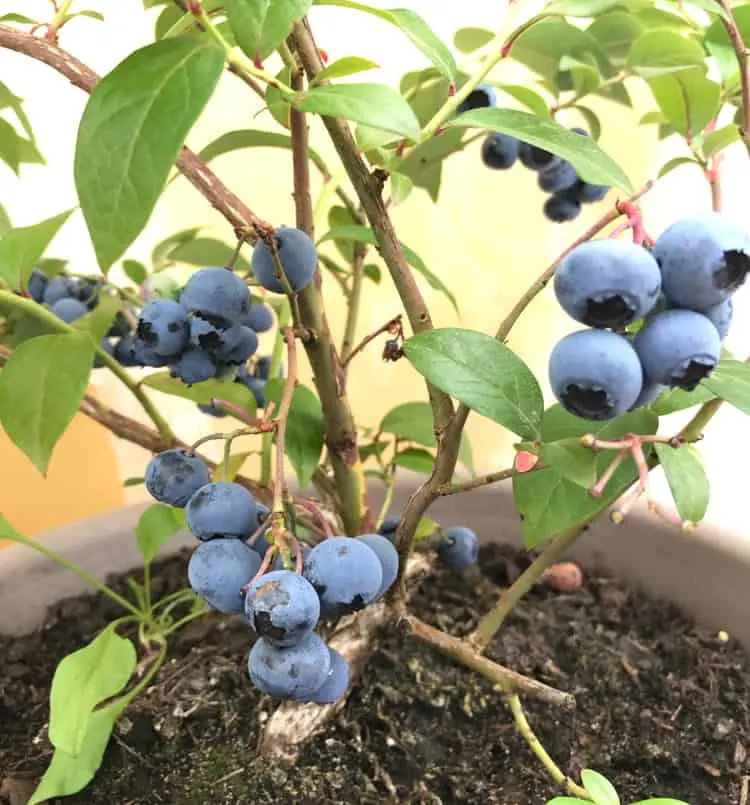
Now your blueberries are all potted up, you need to think carefully about where to position them. Blueberries can be grown:
- On a sunny patio, balcony, or in a sheltered, sunny spot in your garden.
- In an undercover growing structure such as a greenhouse or polytunnel.
- Potentially in an unheated and sunny indoors space. (As long as chill requirements for the variety in question are met, and there is enough light.)
While certain blueberry varieties can tolerate partial/ dappled shade, most blueberries will do best in full sun. They will require at least 6 hours of sunlight a day for best results.
So this is important to bear in mind when you are choosing where to place your blueberries.
In cooler climates, it is also best to place your blueberries in pots in a sheltered position, to protect them from strong winds and colder temperatures.
A position next to a sunny, south-facing wall can be ideal as the thermal mass of the structure will help to keep temperatures more consistent and a little warmer.
In warmer climates, it may be beneficial to position your containers so that the blueberries do get some shade during the hottest part of the day during the peak summer months.
Bear in mind that if you are growing varieties that need companions for fertilization, these should be clustered close together.
It can generally be a good idea to group containers, no matter what you are growing in them since they will be easier for you to tend and water, and the clustered pots will retain heat better than a single pot out on its own.
Tips for Watering Blueberries
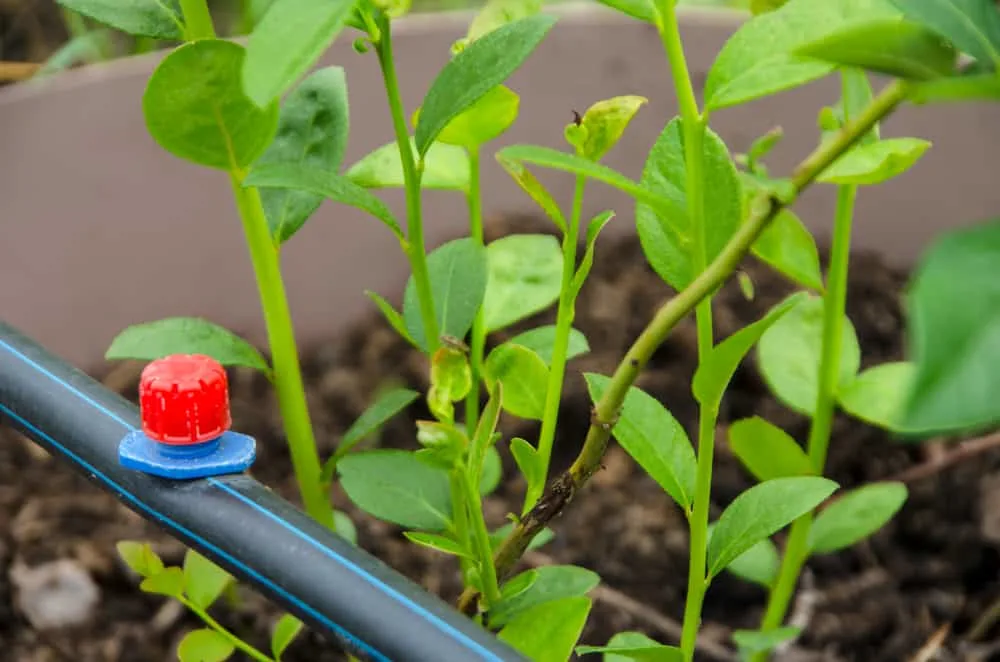
Speaking of watering, it is always important, when growing in pots, to remember that container plants will generally need to be watered more frequently than plants grown in the ground.
As mentioned earlier in this article, blueberries need moist yet free-draining conditions.
They do not like to stand with their roots in water.
It is important to water sufficiently to keep the soil consistently moist, but not too often or too much. Getting the watering right is really the number one challenge when it comes to growing blueberries in pots.
Gardeners that have problems with their blueberries often find that inconsistent or problematic watering is to blame.
Once you have decided where to place your blueberries, it can be a good idea to think about implementing a watering system in order to reduce your workload.
Tap water can reduce the acidity of the growing conditions, and so when you are growing blueberries, it is very important to use rainwater to water the plants.
You can simply water with a watering can. But you could also consider integrating a drip irrigation system for pots and containers into the rainwater harvesting system on your home.
Even in rainy conditions, plants in pots can sometimes end up dry.
The leaves of the plants act as an umbrella. They can actually prevent the rainwater from ending up in the pots.
Directing water through wick irrigation, or through a drip hose can help to make sure that the water actually ends up in the pots, where it can be taken up by plant roots.
Maintaining Fertility in Your Containers
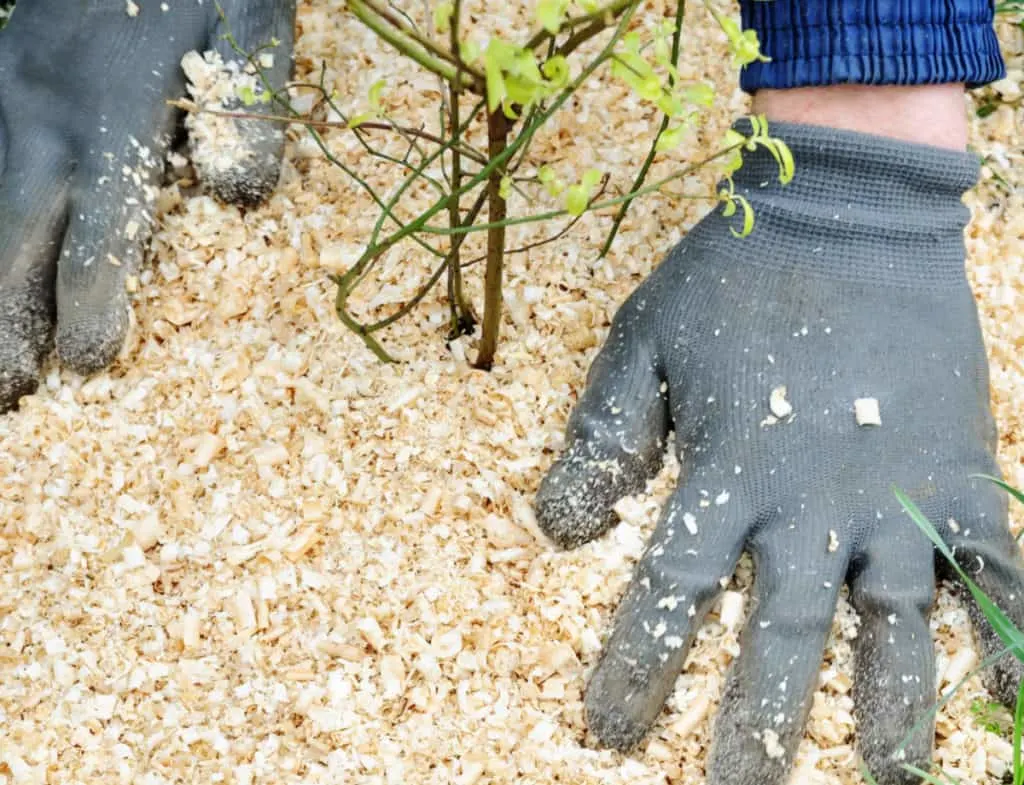
Other than watering, the main task in caring for your blueberries in pots will be maintaining soil acidity and fertility.
Blueberries hate being over-fertilized.
They can suffer if the growing medium is too rich in nutrients. But you will still have to maintain fertility in your containers over time. You will also have to make sure that the potting medium stays acidic.
You can maintain both fertility and acidity by:
- Mulching your pots each spring with a fresh ericaceous mulch of pine needles, oak or beech leaves leaf mold, conifer wood chip or bark chippings.
- Feeding plants with an ericaceous liquid feed/ vinegar solution 2-3 times a year during the growing season.
- Scraping out 1/3 of the potting medium every two-three years and replacing it with fresh ericaceous compost.
Pest Protection for Container Grown Blueberries
Blueberries are generally fairly easy to deal with, and can be fairly resilient to pests. But there can still be pest problems.
Aphids, for example, can sometimes colonize the soft shoot tips of blueberry plants or their leaves to feed on the sap.
In an organic garden, the best way to deal with aphids is by controlling their population. To control the aphid population, plant companion plants to attract natural aphid predators, like ladybugs and lacewings.
Those who grow blueberries in pots, however, are likely to find that the most problematic pests are birds.
If you are not careful, birds can swoop down and eat all of your blueberries before you get the chance to harvest your crop. To reduce losses to birds you could consider:
- Growing blueberries under cover in a greenhouse or polytunnel.
- Placing blueberries in pots inside fruit cages.
- Placing bird netting over the plants a few weeks before the blueberries are ripe.
Winterizing Your Blueberry Containers
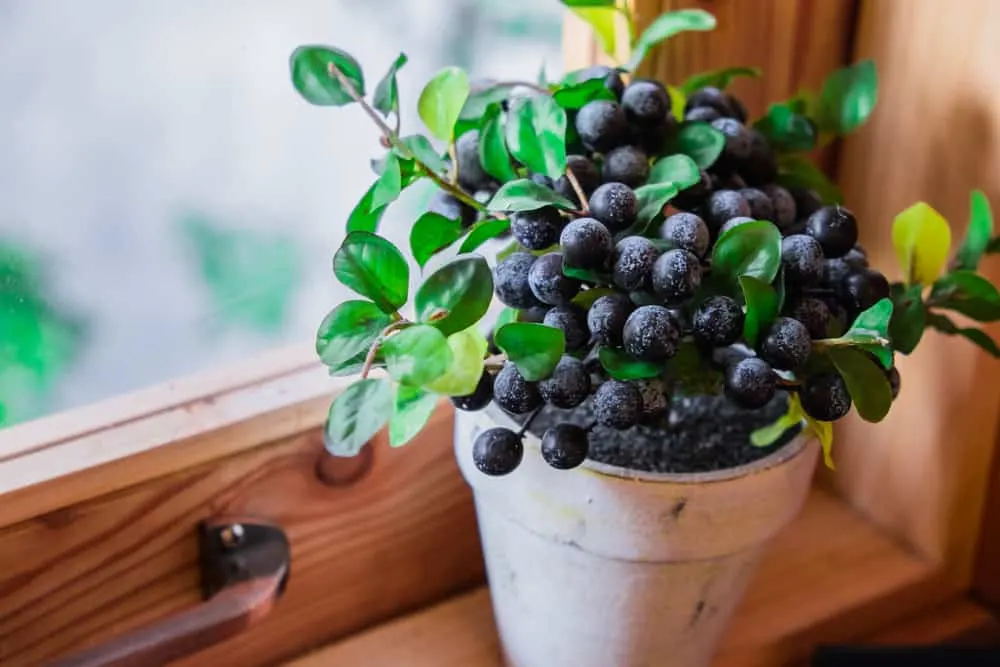
In colder climates, if you are growing your blueberries in pots outside, plants may need some winter protection. Blueberries are relatively hardy, but in the winter:
- Consider moving pots into a more sheltered spot out of the winter wind, or even into an undercover area.
- Insulate the pots with bubble wrap or burlap/hessian. (Especially ceramic pots that can crack if the soil inside freezes solid.)
- Add a mulch of straw around the top of the pots to reduce the chance of the potting medium freezing.
In cold regions, the blossom may need to be protected from a late frost with horticultural fleece or old fabric.
Pruning Your Blueberries
Blueberries will not need to be pruned much, if at all, over their first couple of years.
After that, mature plants can be pruned to maintain size and shape in late February or March each year. When pruning, the aim is to:
- Remove any dead, dying, damaged or diseased stems, or any that have bent down to touch the ground.
- Get rid of twiggy growth at the ends of the branches that fruited the previous year. (Cut back to a low, strong, upward facing bud or branch.)
- Remove around 25% of the oldest and thickest stems at the base of a mature plant, or prune to a younger strong shoot that is low down on the branch.
Harvesting Your Blueberries
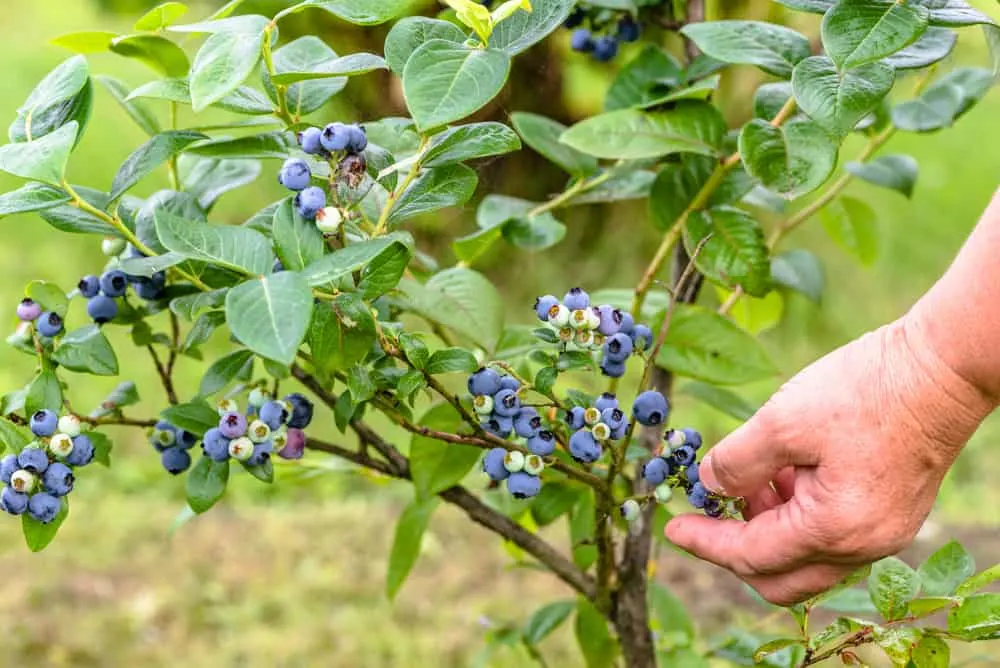
If you have done everything right, you should be able to harvest your blueberries from mid-summer onwards. The berries are ready to harvest when they change color from green to a dusky blue.
There is a little more work involved in harvesting blueberries than there is in harvesting other berries because they do not all ripen at the same time.
You will have to pass over the pick from each plant several times to get all the berries as they ripen.
Blueberries can be eaten right away or cooked into pies, puddings or preserves. Of course, if you want something a little different, I suggest you check out our blueberry recipe round-up for even more ideas. They even freeze beautifully, and freezing blueberries is quite easy once you know how.
These are very versatile fruits with many uses in the kitchen.
So growing blueberries in pots can be a great way to enrich your homegrown diet and make use of even the smallest of spaces.
Of course, if you’re serious about blueberries and you want to be able to pick them by the bucketful each year, you’ll want to read Tracey’s tips for growing buckets of blueberries.
Pin This To Save For Later
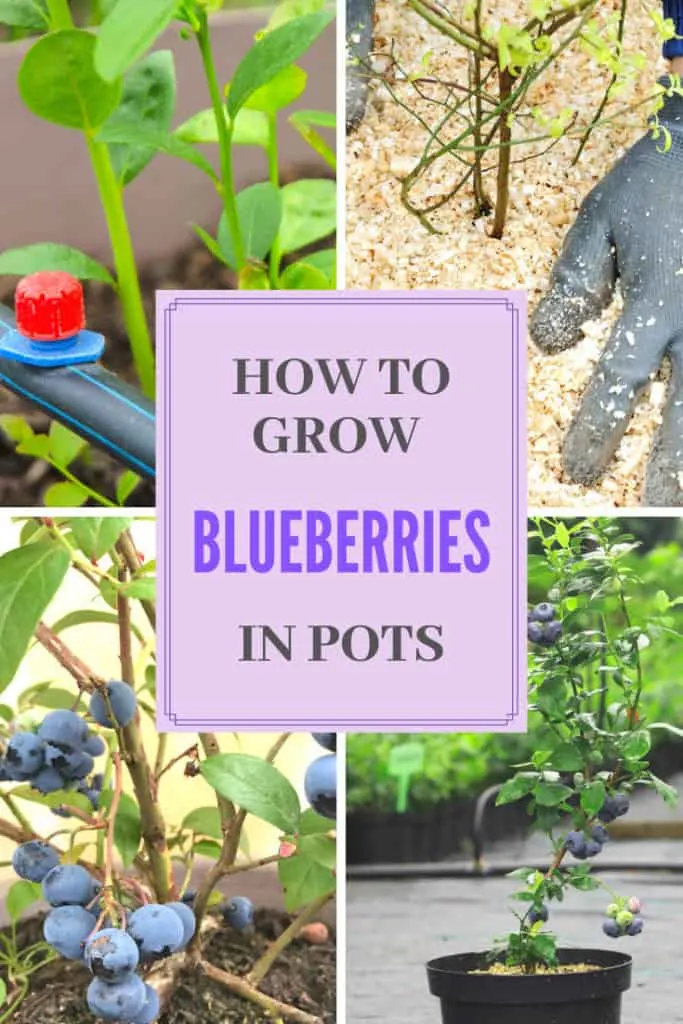

Get the famous Rural Sprout newsletter delivered to your inbox.
Including Sunday ramblings from our editor, Tracey, as well as “What’s Up Wednesday” our roundup of what’s in season and new article updates and alerts.



